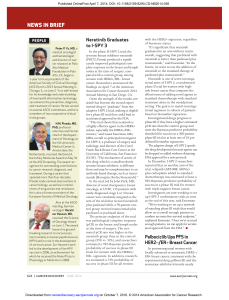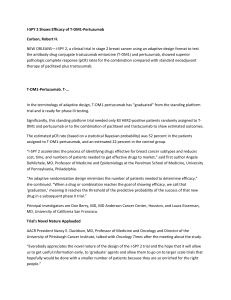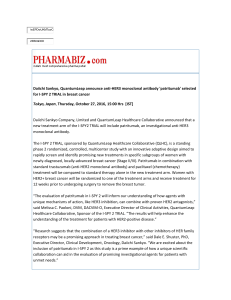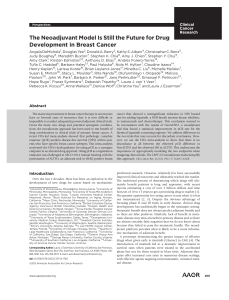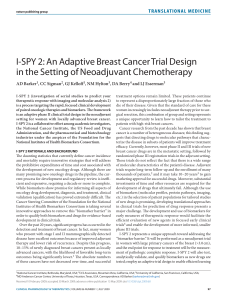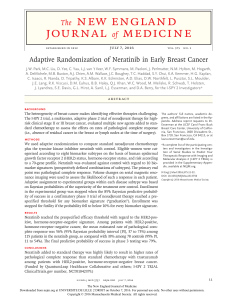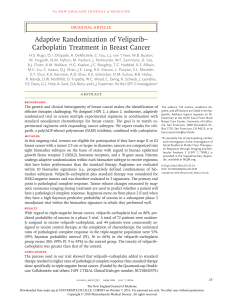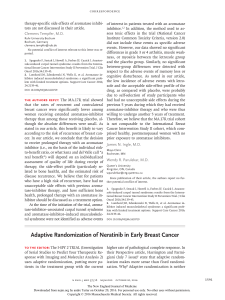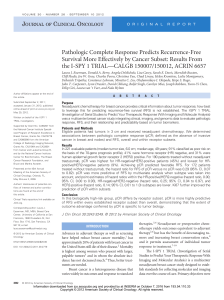I-SPY 2 — Toward More Rapid Progress in Breast Cancer Treatment
publicité
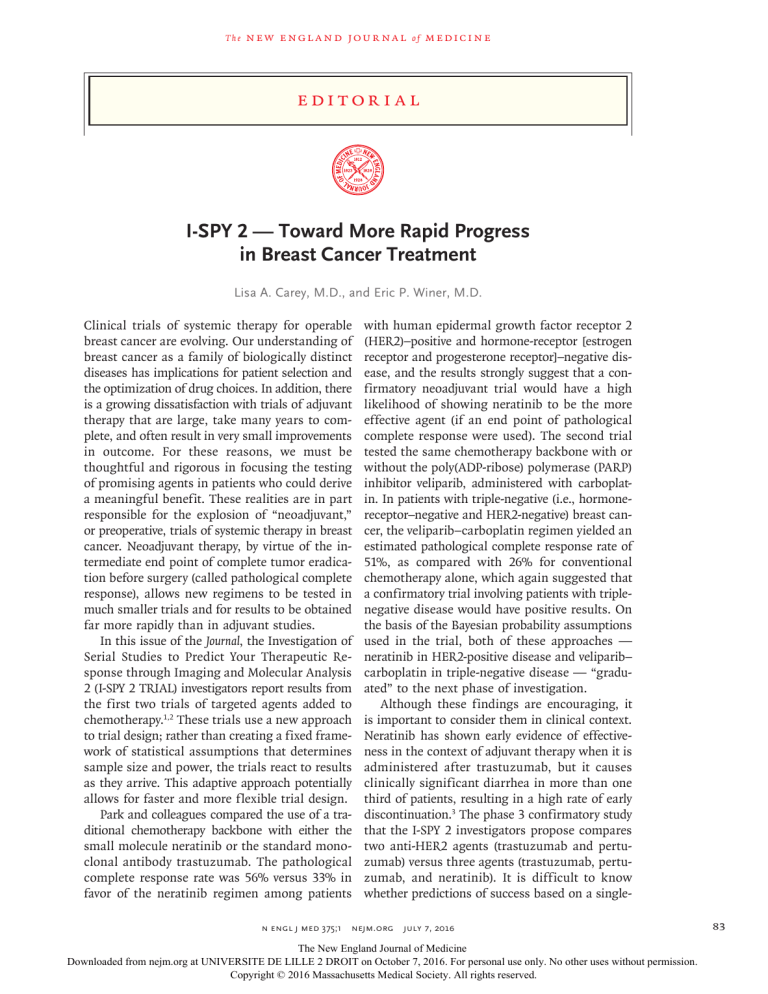
The n e w e ng l a n d j o u r na l of m e dic i n e Edi t or i a l I-SPY 2 — Toward More Rapid Progress in Breast Cancer Treatment Lisa A. Carey, M.D., and Eric P. Winer, M.D. Clinical trials of systemic therapy for operable breast cancer are evolving. Our understanding of breast cancer as a family of biologically distinct diseases has implications for patient selection and the optimization of drug choices. In addition, there is a growing dissatisfaction with trials of adjuvant therapy that are large, take many years to complete, and often result in very small improvements in outcome. For these reasons, we must be thoughtful and rigorous in focusing the testing of promising agents in patients who could derive a meaningful benefit. These realities are in part responsible for the explosion of “neoadjuvant,” or preoperative, trials of systemic therapy in breast cancer. Neoadjuvant therapy, by virtue of the intermediate end point of complete tumor eradication before surgery (called pathological complete response), allows new regimens to be tested in much smaller trials and for results to be obtained far more rapidly than in adjuvant studies. In this issue of the Journal, the Investigation of Serial Studies to Predict Your Therapeutic Response through Imaging and Molecular Analysis 2 (I-SPY 2 TRIAL) investigators report results from the first two trials of targeted agents added to chemotherapy.1,2 These trials use a new approach to trial design; rather than creating a fixed framework of statistical assumptions that determines sample size and power, the trials react to results as they arrive. This adaptive approach potentially allows for faster and more flexible trial design. Park and colleagues compared the use of a traditional chemotherapy backbone with either the small molecule neratinib or the standard monoclonal antibody trastuzumab. The pathological complete response rate was 56% versus 33% in favor of the neratinib regimen among patients with human epidermal growth factor receptor 2 (HER2)–positive and hormone-receptor [estrogen receptor and progesterone receptor]–negative disease, and the results strongly suggest that a confirmatory neoadjuvant trial would have a high likelihood of showing neratinib to be the more effective agent (if an end point of pathological complete response were used). The second trial tested the same chemotherapy backbone with or without the poly(ADP-ribose) polymerase (PARP) inhibitor veliparib, administered with carboplatin. In patients with triple-negative (i.e., hormonereceptor–negative and HER2-negative) breast cancer, the veliparib–carboplatin regimen yielded an estimated pathological complete response rate of 51%, as compared with 26% for conventional chemotherapy alone, which again suggested that a confirmatory trial involving patients with triplenegative disease would have positive results. On the basis of the Bayesian probability assumptions used in the trial, both of these approaches — neratinib in HER2-positive disease and veliparib– carboplatin in triple-negative disease — “graduated” to the next phase of investigation. Although these findings are encouraging, it is important to consider them in clinical context. Neratinib has shown early evidence of effectiveness in the context of adjuvant therapy when it is administered after trastuzumab, but it causes clinically significant diarrhea in more than one third of patients, resulting in a high rate of early discontinuation.3 The phase 3 confirmatory study that the I-SPY 2 investigators propose compares two anti-HER2 agents (trastuzumab and pertuzumab) versus three agents (trastuzumab, pertuzumab, and neratinib). It is difficult to know whether predictions of success based on a single- n engl j med 375;1 nejm.org July 7, 2016 The New England Journal of Medicine Downloaded from nejm.org at UNIVERSITE DE LILLE 2 DROIT on October 7, 2016. For personal use only. No other uses without permission. Copyright © 2016 Massachusetts Medical Society. All rights reserved. 83 Editorial agent trial can be extrapolated when multiple agents are combined. It is also possible, if not probable, that the three-drug regimen proposed would have considerable toxic effects when added to chemotherapy. This approach raises concerns and could result in substantial overtreatment of a large proportion of the patient population. In triple-negative disease, recent studies have consistently found a higher pathological complete response rate with the addition of platinum drugs4,5; given that the investigational regimen in the study by Rugo et al. included the addition of both a PARP inhibitor and a platinum drug, it is possible that the results were driven partially or entirely by the inclusion of the additional cytotoxic drug rather than by the targeted agent. The potential for unmeasured variables to influence the results must be considered. We have learned that many nontreatment factors contribute to response to therapy in both HER2-positive and triple-negative breast cancer, such as intrinsic subtype and the presence or activity of tumorinfiltrating lymphocytes.6-8 These may be particularly relevant in small studies in which baseline imbalances can produce outsize effects. For these reasons, although the results of these studies are intriguing, the main benefit of the I-SPY 2 approach is in quickly providing data that can help investigators choose which of several promising new approaches to pursue in larger trials. These two multicenter trials may ultimately lead to changes in treatment in the years ahead. The investigators created a collaborative culture around these studies, and the work that appears in the Journal would not have been possible absent that spirit of cooperation and collective creativity. However, these trials were not designed to predict the ultimate success of either neratinib or carboplatin–veliparib in improving disease-free or overall survival. Instead, they predict a positive result with the use of pathological complete response rate as an end point in a definitive neoadjuvant study. Clinicians should remember that pathological complete response rate itself is not a clinically meaningful end point; its value is as a surrogate for outcome. Although pathological complete response rate is consistently associated with a decreased risk of relapse and death for individual patients,9 even substantial improvements in pathological complete response rate in neoadjuvant trials have not consistently translated into improvement in long-term outcomes. The reasons for this are myriad, including the molecular heterogeneity 84 of breast cancer and the possible effect of postsurgical interventions. Most importantly, pathological complete response rate will correlate with survival outcomes only if the neoadjuvant agents leading to the improvement in pathological complete response also eradicate resistant tumor clones. At this time, improvements in pathological complete response rates as reported in neoadjuvant studies — whether the studies are exploratory, such as I-SPY 2, or more definitive — should not change clinical practice; rather, we should wait for the definitive clinical trials that result from them. Nonetheless, standard neoadjuvant therapy remains a sound clinical approach with the potential to individualize therapy. It also remains a valuable research tool that has the potential to help us develop hypotheses and explore mechanisms of drug resistance. Disclosure forms provided by the authors are available with the full text of this article at NEJM.org. From the Division of Hematology–Oncology, Lineberger Comprehensive Cancer Center, University of North Carolina at Chapel Hill, Chapel Hill (L.A.C.); and the Breast Oncology Program, Dana–Farber Cancer Institute, Boston (E.P.W.). 1. Park JW, Liu MC, Yee D, et al. Adaptive randomization of neratinib in early breast cancer. N Engl J Med 2016;375:11-22. 2. Rugo HS, Olopade OI, DeMichele A, et al. Adaptive randomization of veliparib–carboplatin treatment in breast cancer. N Engl J Med 2016;375:23-34. 3. Chan A, Delaloge S, Holmes FA, et al. Neratinib after trastuzumab-based adjuvant therapy in patients with HER2-positive breast cancer (ExteNET): a multicentre, randomised, doubleblind, placebo-controlled, phase 3 trial. Lancet Oncol 2016;17: 367-77. 4. Sikov WM, Berry DA, Perou CM, et al. Impact of the addition of carboplatin and/or bevacizumab to neoadjuvant once-perweek paclitaxel followed by dose-dense doxorubicin and cyclophosphamide on pathologic complete response rates in stage II to III triple-negative breast cancer: CALGB 40603 (Alliance). J Clin Oncol 2015;33:13-21. 5. von Minckwitz G, Schneeweiss A, Loibl S, et al. Neoadjuvant carboplatin in patients with triple-negative and HER2-positive early breast cancer (GeparSixto; GBG 66): a randomised phase 2 trial. Lancet Oncol 2014;15:747-56. 6. Carey LA, Berry DA, Cirrincione CT, et al. Molecular heterogeneity and response to neoadjuvant human epidermal growth factor receptor 2 targeting in CALGB 40601, a randomized phase III trial of paclitaxel plus trastuzumab with or without lapatinib. J Clin Oncol 2016;34:542-9. 7. Gianni L, Bianchini G, Valagussa P, et al. Adaptive immune system and immune checkpoints are associated with response to pertuzumab (P) and trastuzumab (H) in the NeoSphere study. Cancer Res 2012;72:24 Suppl:S6-7. abstract. 8. Loi S, Michiels S, Salgado R, et al. Tumor infiltrating lymphocytes are prognostic in triple negative breast cancer and predictive for trastuzumab benefit in early breast cancer: results from the FinHER trial. Ann Oncol 2014;25:1544-50. 9. Cortazar P, Zhang L, Untch M, et al. Pathological complete response and long-term clinical benefit in breast cancer: the CTNeoBC pooled analysis. Lancet 2014;384:164-72. DOI: 10.1056/NEJMe1603691 Copyright © 2016 Massachusetts Medical Society. n engl j med 375;1 nejm.org July 7, 2016 The New England Journal of Medicine Downloaded from nejm.org at UNIVERSITE DE LILLE 2 DROIT on October 7, 2016. For personal use only. No other uses without permission. Copyright © 2016 Massachusetts Medical Society. All rights reserved.
